Dr. Phil Zeltzman’s Blog
Ninja, my biggest surgical & ethical challenge in 2021
“I beg you for help.”
Such was the subject line of the email.
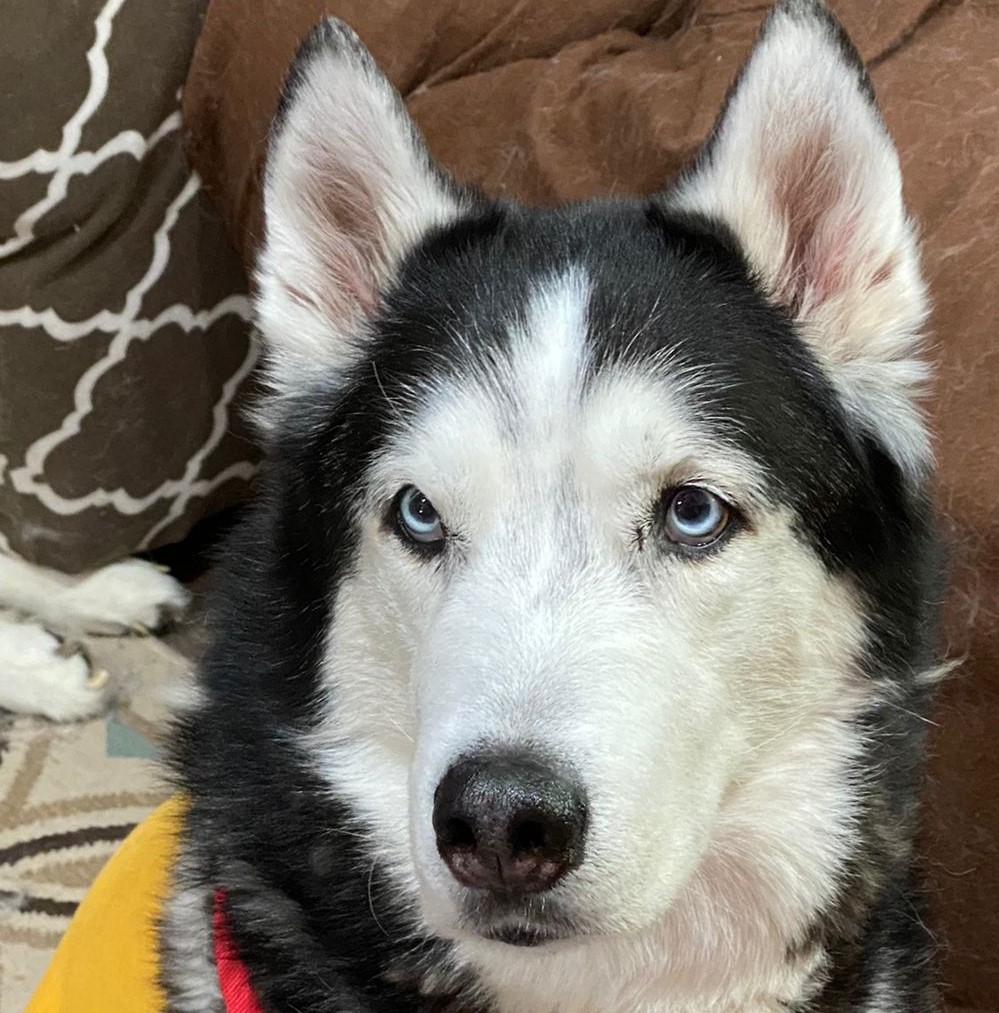
In the email, a pet owner explained:
“My dog Ninja, a 6 year old Siberian Husky, just had a CAT scan, then surgery to drain a cyst in his enlarged prostate” (17 cm long – about 7 inches).
“Because of the pressure on the colon and the bladder, Ninja couldn’t defecate or urinate!”
“His bladder has been so over-stretched, that it couldn’t contract and now Ninja still can’t urinate. A urinary catheter was placed temporarily… and the only option the surgeon gave us was euthanasia!”
“I don’t want to put him down. He is eating, drinking and (now) pooping. He acts normal but can’t pee. Please help me, I am very desperate.”
Desperate times call for desperate measures.
Ninja had a condition similar to unfortunate older gentlemen who struggle to pee because of an enlarged prostate. It is a frustrating & painful situation. But in a dog, it can be life-threatening.
There is a better solution than euthanasia. I suggested a surgery that involves placing a special tube in the bladder and allows draining the bladder on demand.
It’s certainly not for every pet owner, but Ninja’s owners were exactly the right people for the challenge: dedicated, attentive, and totally in tune with their dog. They had done their homework and found out about this option by reading my blog about Madeline, who had the same surgery for a different problem (a bladder tumor).
Chapter 1
Time was of the essence, so we quickly scheduled surgery at Brodheadvsille Vet Clinic.
Ninja had a “cystostomy” surgery, where a tube was placed to drain the bladder through an opening in the skin.
In addition, Ninja was neutered. After that necessary step, male hormones would decrease and cause the prostate to shrink. That would reduce the pressure on the urethra and allow Ninja to urinate.
Chapter 2
Everything went according to plan for about a month… until Ninja accidentally stepped on the tube.
The logical next step was to replace the life-saving drain. Unfortunately, preop bloodwork showed some concerning changes. Ninja’s immune system was attacking his own red blood cells (hemolytic anemia) and platelets (thrombocytopenia). This double condition is called Evans’ syndrome.
So we changed plans. Since it was too risky to perform surgery with such low numbers of red blood cells and platelets, we placed a traditional urinary catheter to allow Ninja to urinate.
We were able to do this thanks to the generosity of another practice owner near Allentown, PA.
The catheter had to be changed frequently to lower the risk of bladder infection (UTI).
His faithful owners would drain the bladder multiple times a day to allow it to stay small. Remember, the bladder was so over-stretched, that it couldn’t contract anymore…
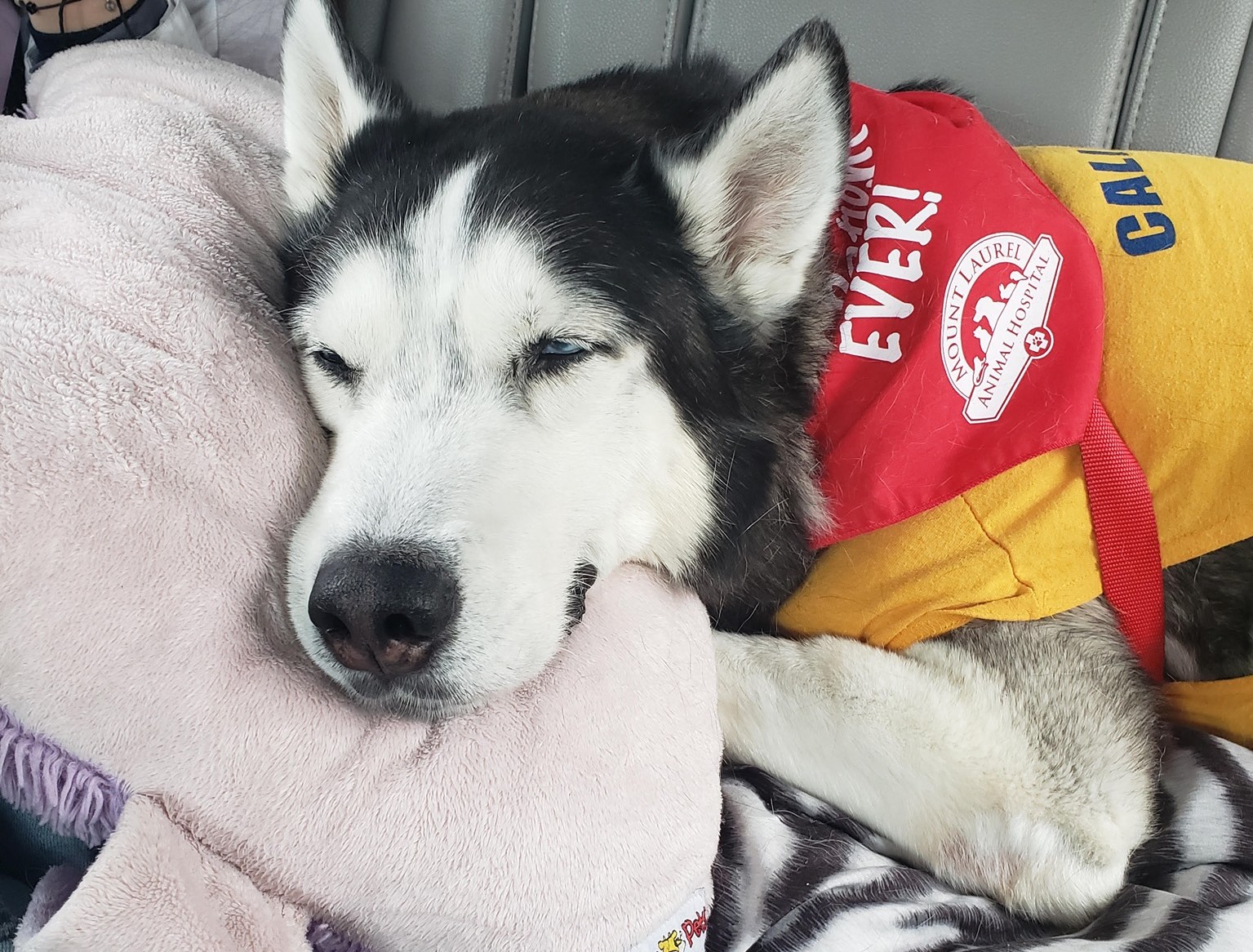
Chapter 3
At that point, Ninja was referred to a board-certified internist (a medicine specialist) to manage his Evans syndrome.
Meanwhile, Ninja still couldn’t pee!
To make matters worse, an ultrasound showed that the prostate now had an abscess. Again, euthanasia was recommended.
Again, his owner called me to see if there were any other options.
After reaching out to multiple specialists, we found one willing to help. My amazing nurse and I suggested a completely crazy plan:
. An ICU specialist at a specialty hospital in NJ accepted to let us use the key to our problem: a special transfusion with platelets to help with clotting.
. We would drain the abscess at another practice in NJ, and place a new cystostomy tube to allow Ninja to pee.
. We would recover Ninja under the supervision the ICU specialist.
Amazingly, Ninja’s owners decided to go with surgery, about 2 months after the first one.
The procedure was uneventful, and after 2 days in ICU, Ninja went home.
Then came weeks and months of amazing dedication from Ninja’s owners.
Long story short, Ninja progressively got better and stronger.
Then out of the blue, to everybody’s surprise, he started to pee on his own!
After agonizing over the right time to remove the tube, we eventually did, once we were convinced that Ninja was emptying his bladder on his own sufficiently to survive.
Now you understand why Ninja was such a technical and mostly ethical dilemma for me.
When should a surgeon stop helping?
When should a pet owner stop hoping?
When should a pet to cross the rainbow bridge?
Why did I choose Ninja’s story…
… over so many other amazing pet stories I was fortunate to play a part in in 2021?
Because of the number of people who played a role in Ninja’s survival.
In the middle of the COVID crisis, it was an absolutely astonishing display of generosity, love and care, by multiple vets and nurses.
Across half a dozen practices.
And across 2 States (PA & NJ).
(trust me, I gave you the short version!!!)
Everybody rallied behind Ninja, led by his loving owners.
And the result is one happy, playful, fluffy Husky, whose only wish is to be comfortable, to be able to pee, and to return his owners’ love.
Ninja’s owner created an amazing video summary.
It’s a story about the love of a family pet.
A story about the power of dedication.
A story about not taking no for an answer.
You can watch it here: https://vm.tiktok.com/ZMRatj6Co/
Fair warning: it’s a tiny bit emotional…
What’s the moral of the story?
1. Neutering early in life decreases or eliminates the chances of having prostate issues in male dogs. There are many other good reasons, which you can read about here:
/blog/top-10-reasons-to-neuter-your-pet/
2. You are your pet’s best advocate. If something makes no sense to you, don’t give up. Sadly, there is not a solution or a cure for every condition. But at least, you should explore your options.
Don’t take no for an answer. Get a second opinion.
This is exactly what Madeline’s and Ninja’s owners did. They didn’t take no for an answer, and they saved their dogs’ lives.
Phil Zeltzman, DVM, DACVS, CVJ, Fear Free Certified

Dr. Phil Zeltzman is a traveling veterinary surgeon in Pennsylvania & New Jersey. An award-winning author, he loves to share his adventures in practice along with information about vet medicine and surgery that can really help your pets. Dr. Zeltzman specializes in orthopedic, neurologic, cancer, and soft tissue surgeries for dogs, cats, and small exotics. By working with local family vets, he offers the best surgical care, safest anesthesia, and utmost pain management to all his patients. Sign up to get an email when he updates his blog, and follow him on Facebook, too!
4 things you should never say or hear about lumps
Removing skin masses is one of my most common surgeries.
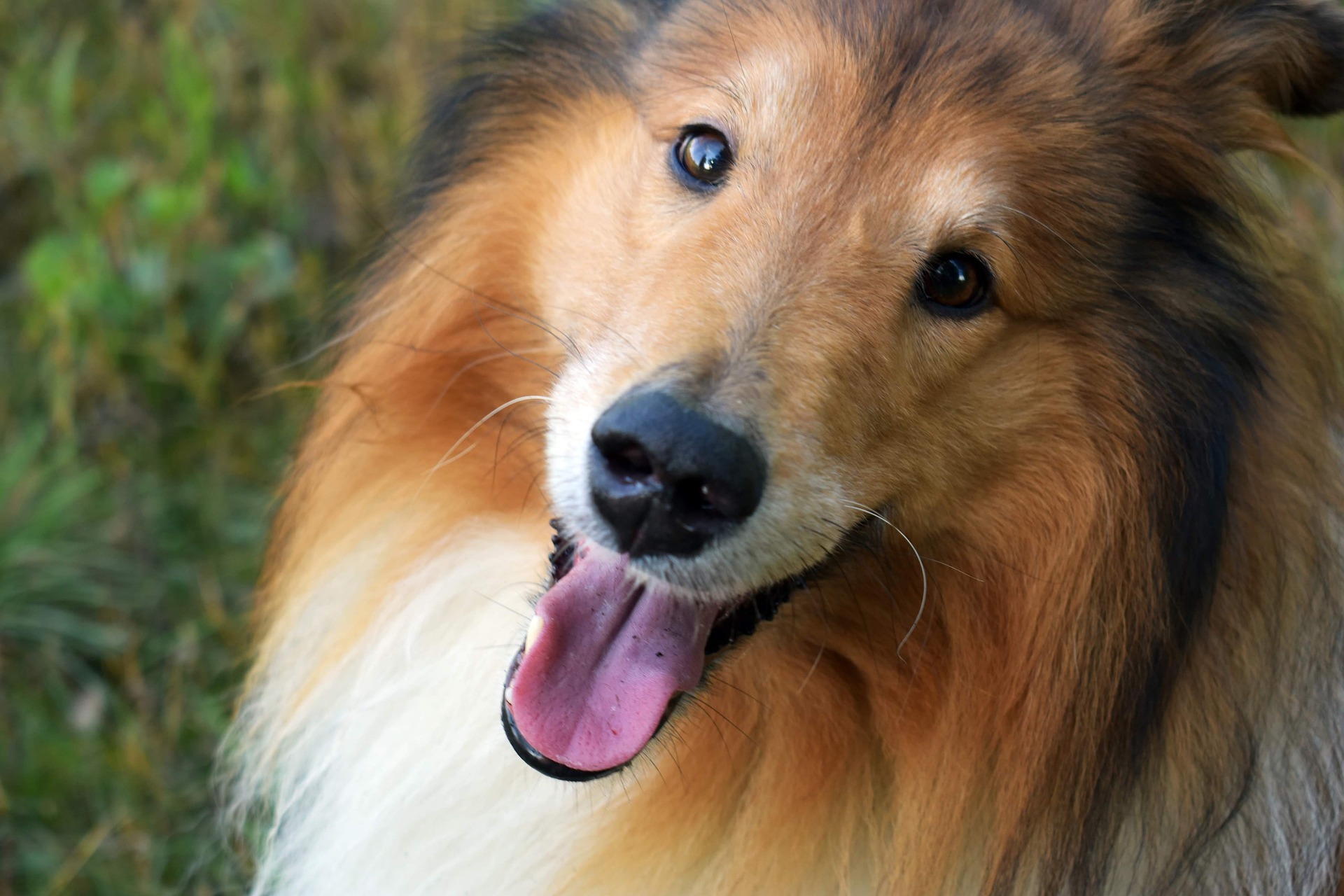
Some skin masses are small. Some are in difficult locations, making the surgery tricky. Some are gigantic. Many were claimed to be “impossible to remove” – yet we still removed them. Some were supposed to be cancerous – and were benign. Some were supposed to be benign – and were cancerous. Yet others were indeed impossible to remove and required leg amputation.
What’s a pet lover to do? What is the right thing to do?
The problem with small skin masses is that they can be very misleading. I have come across multiple tiny masses, sometimes the size of a grain of rice, that were aggressive cancers.
Here is an example of a 1/3 inch mass, barely visible, hard to feel, under a cat’s fur. By some miracle, his owner found the mass and wisely decided to have it removed.
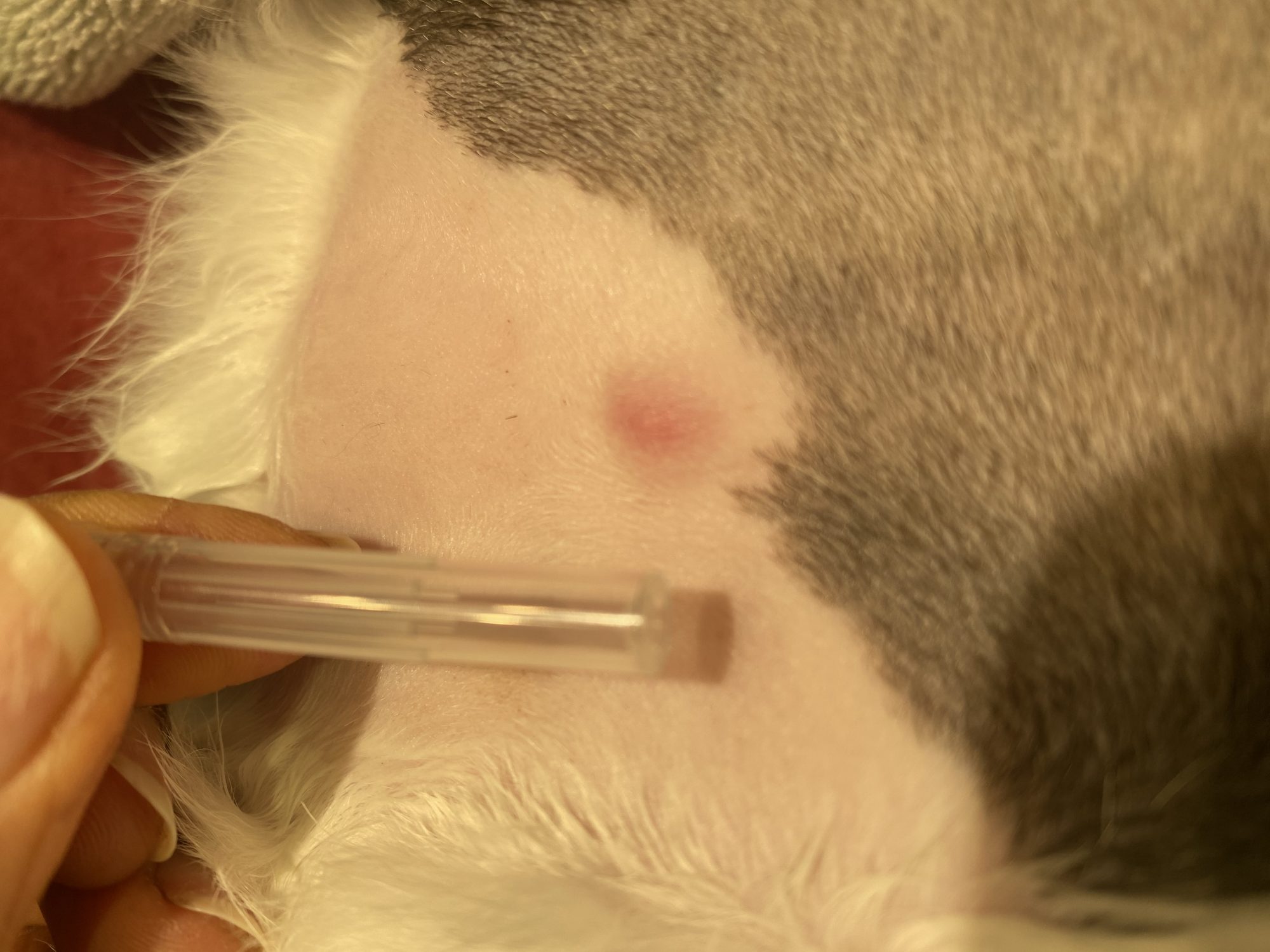
The biopsy revealed a fibrosarcoma, which is a notoriously aggressive cancer in cats.
Here are the 4 things you should never say or hear about lumps:
. “Just watch it.”
. “Keep an eye on it.”
. “It’s just a cyst.”
. “It’s just a fatty tumor.”
“Just watching” a mass grow bigger and bigger, or “keeping an eye” on a mass that keeps getting larger and larger, is exactly how we end up with masses the size of pumpkins.
By then, surgery is much more invasive, anesthesia is much longer, and the fees are much higher.
The “cyst” myth is just as unfortunate. A cyst is an actual diagnosis. It’s typically a benign mass that is usually filled with fluid. There are different types of cysts: follicular or epidermoid cysts, sebaceous cysts, dermoid cysts etc.
But the vast majority of so-called “cysts” I remove are not cysts. It was an assumption by the pet owner. “Cyst” is often used instead of “mass” or “tumor,” and it’s misleading at best.
“It’s just a fatty tumor” is something else I hear all the time. If someone tells you that, you should have a reasonable degree of doubt. NOBODY can assure you with 100% certainty that they know the diagnosis of a mass with further testing.
Why? Because I have never met anybody with microscopic vision.
You can only say what a mass is after testing it.
Case in point: a mast cell tumor is a very common skin tumor. It is nicknamed “the great imitator” because it can feel like anything – including a benign fatty tumor. As you can imagine, mistaking a benign tumor for a cancerous one can lead to really frustrating situations.
| 2 tests for skin masses: There are 2 ways to test a mass. 1. A needle test: During a needle test or Fine Needle Aspirate (or FNA), a needle is placed in the mass. Some cells are taken out and placed on a glass slide. It is then read under the microscope. It can either be read “in house,” meaning by your vet, or ideally it is sent out to a pathologist, who reads the cytology (ie the study of cells). My personal impression is that although cytology is cheaper and faster (a few days), it can provide misleading results. 2. A biopsy: A biopsy is a way to take a sample of the mass, ie some actual tissue, and not just cells. Being able to study the cells’ architecture, organization and relationship provides completely different information and a much safer diagnosis. The biopsy is always sent to a pathologist, who reads the histo-pathology (ie the study of abnormal tissue). My personal impression is that although a biopsy cytology is more expensive and take longer to read (7-10 days), it provides the most reliable results. |
So what’s a loving pet owner to do?
At a minimum, skin masses should get tested via a needle test. Occasionally, they should be biopsied before surgery. Ideally, they should be removed and biopsied. Admittedly, it can get expensive since some dogs seem to be covered in masses, sometimes benign fatty masses. That’s where pet insurance is so helpful.
Here is an example of a giant mass in a Lab, whose owner was told to “just watch it” because it was tested as a benign fatty tumor.
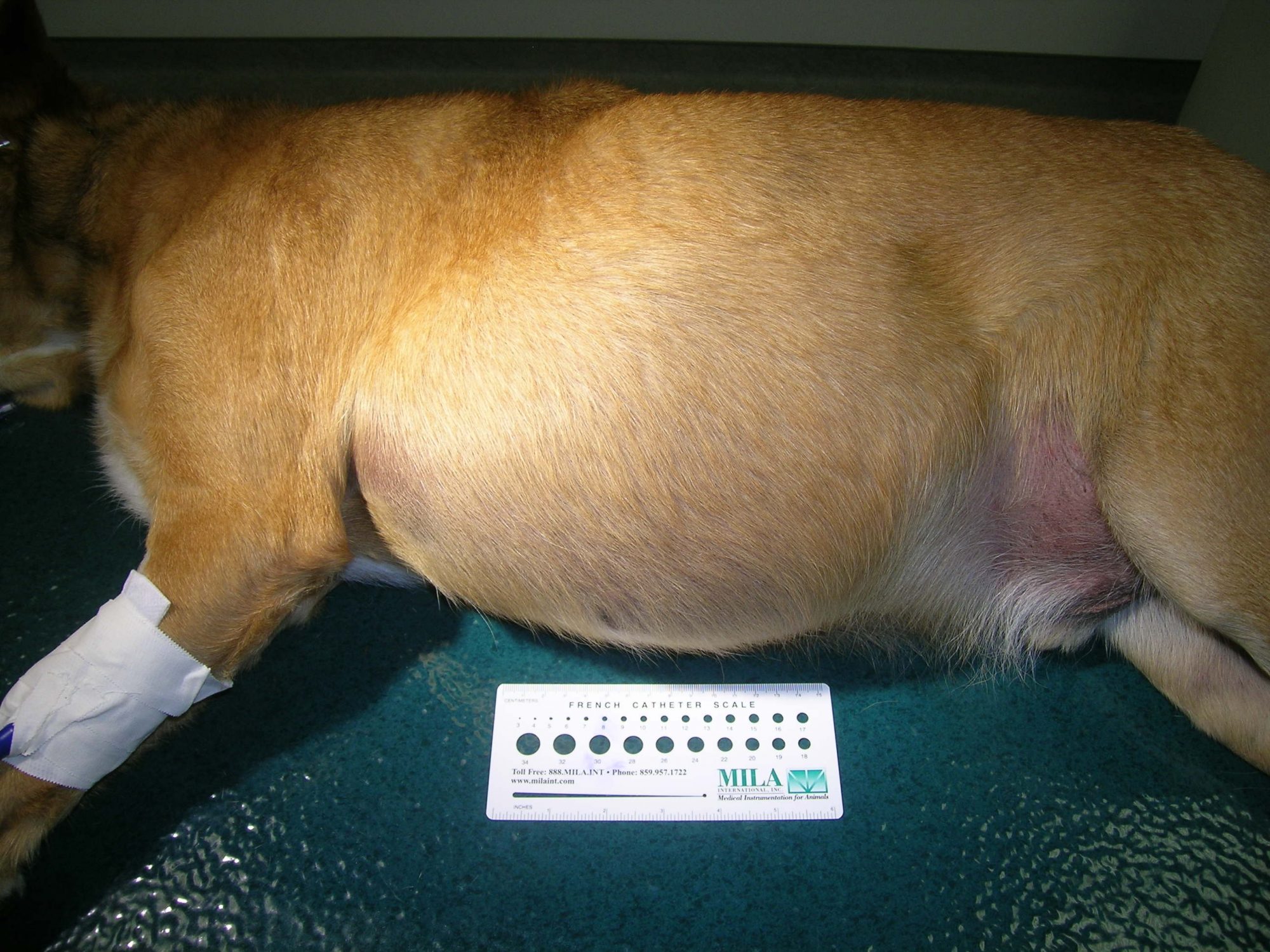
So why bother if a mass is benign?
Benign doesn’t mean you should ignore it.
I have removed benign masses that were the size of a tennis ball, or a grapefruit, that prevented the patient from walking normally. I have removed benign masses that required leg amputation. And I have removed benign masses that were the size of a pumpkin that caused pain (by stretching the skin) and made the patients lose their balance.
If you find yourself in a situation where your vet seems to be brushing something off that genuinely concerns you, you have the right to seek a second opinion and I would encourage you to do so.
Bottom line: waiting is rarely a wise option.
Phil Zeltzman, DVM, DACVS, CVJ, Fear Free Certified

Dr. Phil Zeltzman is a traveling veterinary surgeon in Pennsylvania & New Jersey. An award-winning author, he loves to share his adventures in practice along with information about vet medicine and surgery that can really help your pets. Dr. Zeltzman specializes in orthopedic, neurologic, cancer, and soft tissue surgeries for dogs, cats, and small exotics. By working with local family vets, he offers the best surgical care, safest anesthesia, and utmost pain management to all his patients. Sign up to get an email when he updates his blog, and follow him on Facebook, too!
Will Weez need an amputation?
Weez, a cute 12 year old Cockapoo, had a swelling under her left armpit (aka the axilla).
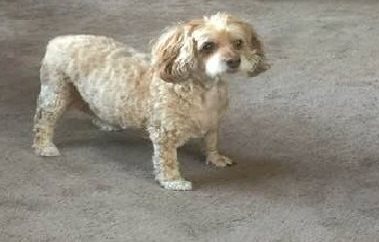
No signs were present otherwise: she was eating, drinking and acting normally.
Since the swelling continued to grow, her owner wisely went to see his family vet. She diagnosed a mass of unknown origin.
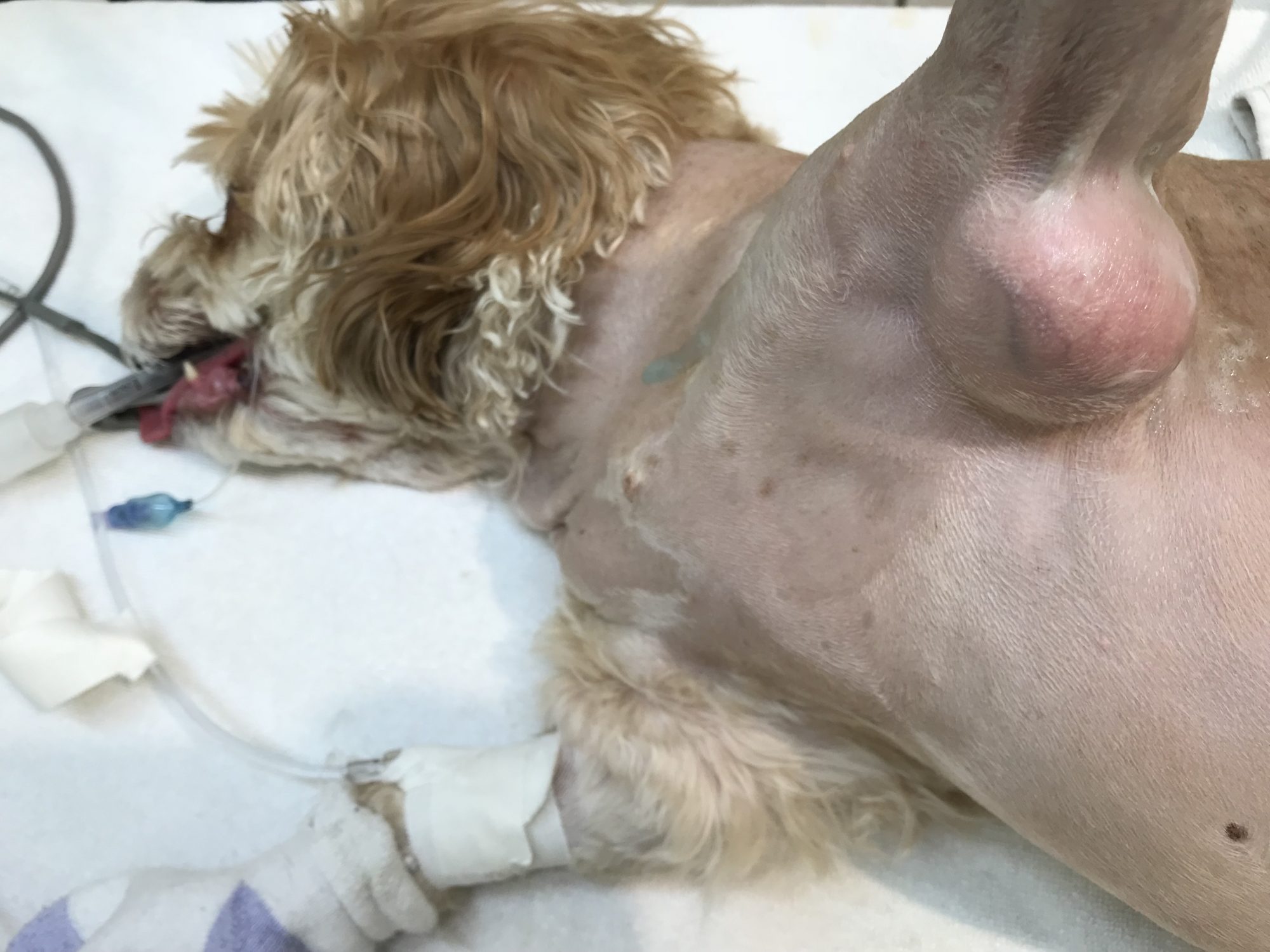
The vet (again, wisely), recommended surgery to remove it and biopsy it.
The suspicion, based on experience, the location of the mass and its fast growth, suggested that it was likely a cancerous mass (soft tissue sarcoma, nerve sheath tumor, lymphoma etc.). In addition, there was a chance that it involved some important nerves in the armpit (aka the brachial plexus).
Since those nerves cannot be sacrificed, we discussed a small possibility of amputation.
A physical exam and blood work confirmed than Weez was a good candidate for anesthesia.
To my relief, my own exam revealed that there was no need to sacrifice the leg!
So we removed the mass uneventfully, and it as sent to the lab for analysis.
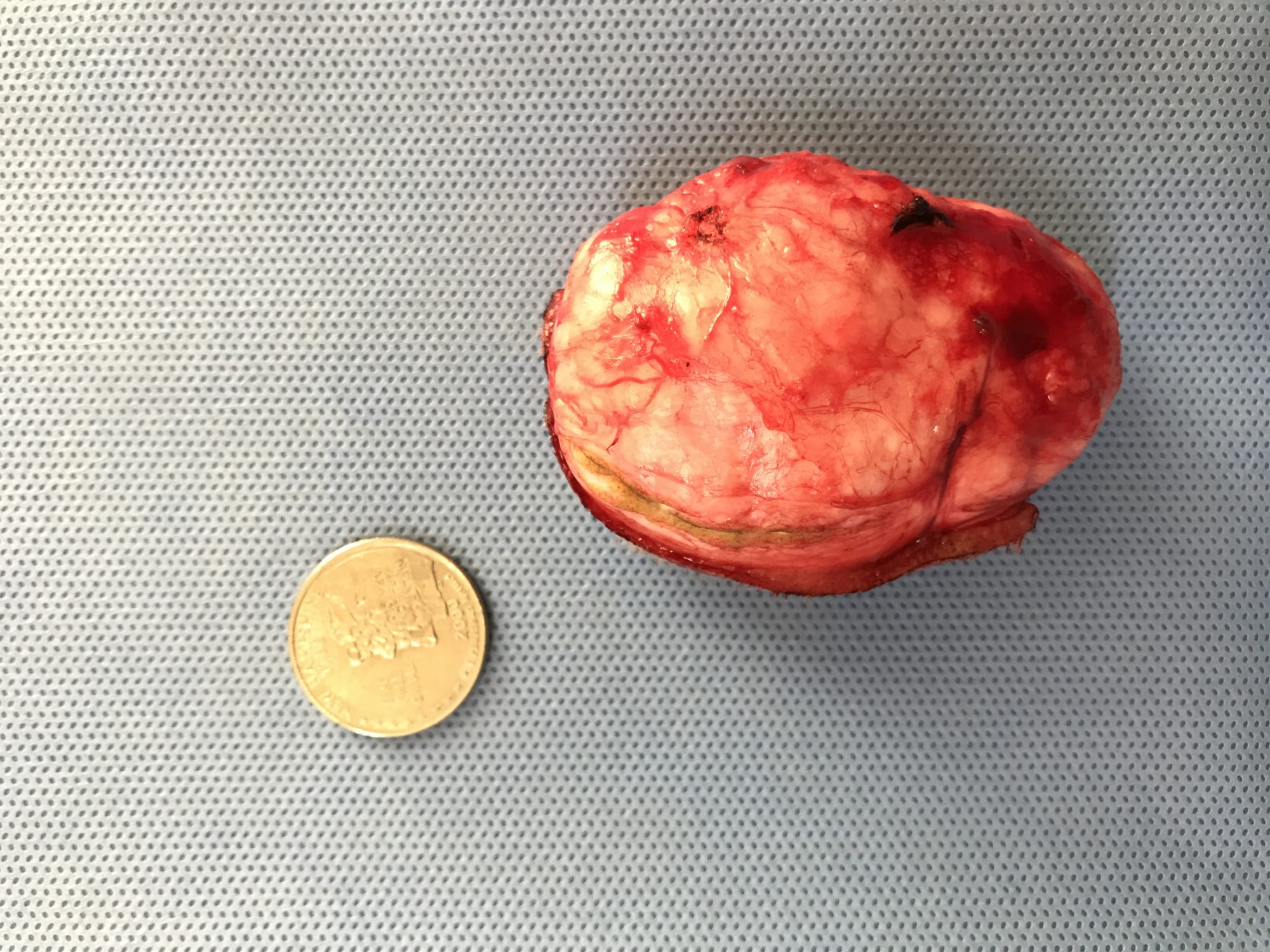
Weez recovered smoothly from anesthesia and surgery, and went home.
Her activity had to be restricted and she had to wear a cone (E-collar) around her beck for 3 weeks. She was also given oral antibiotics and pain medications.
One week later, the results of the biopsy were shocking – in a fantastic way!
Amazingly, the mass was benign! It is called a fibroma, which is a non-cancerous tumor, and very unusual in that location.
There is still a small risk that the tumor can come back, so I asked Weez’s owner to monitor the area by feeling it monthly.
Weez’s owner was ecstatic. He wrote: “Cannot be any happier and blessed to have had Dr. Zeltzman operate on our girl. He was able to remove a tumor and save her leg from being amputated.”
This story reminds me that board-certified cancer specialists (oncologists) and surgeons have 2 similar sayings:
* The 3 deadliest words in the English language are “Just watch it” and
* The 5 deadliest words in the English language are “Keep an eye on it.”
What we mean by that is size doesn’t matter when it comes to masses.
A tiny mass the size of a grain of rice can be cancer.
Bottom line: even though this mass was luckily benign, it is important to remove masses as soon as possible. Have your family vet check your cat or your dog as soon as you notice any lump or bump, so that they can guide you through the next steps.
So please don’t procrastinate. Removing a mass when it’s small is less invasive, less costly, and gives much better chances for a cure.
Phil Zeltzman, DVM, DACVS, CVJ, Fear Free Certified

Dr. Phil Zeltzman is a traveling veterinary surgeon in Pennsylvania & New Jersey. An award-winning author, he loves to share his adventures in practice along with information about vet medicine and surgery that can really help your pets. Dr. Zeltzman specializes in orthopedic, neurologic, cancer, and soft tissue surgeries for dogs, cats, and small exotics. By working with local family vets, he offers the best surgical care, safest anesthesia, and utmost pain management to all his patients. Sign up to get an email when he updates his blog, and follow him on Facebook, too!
Owners’ smart choice saves Boston Terrier from difficult surgery
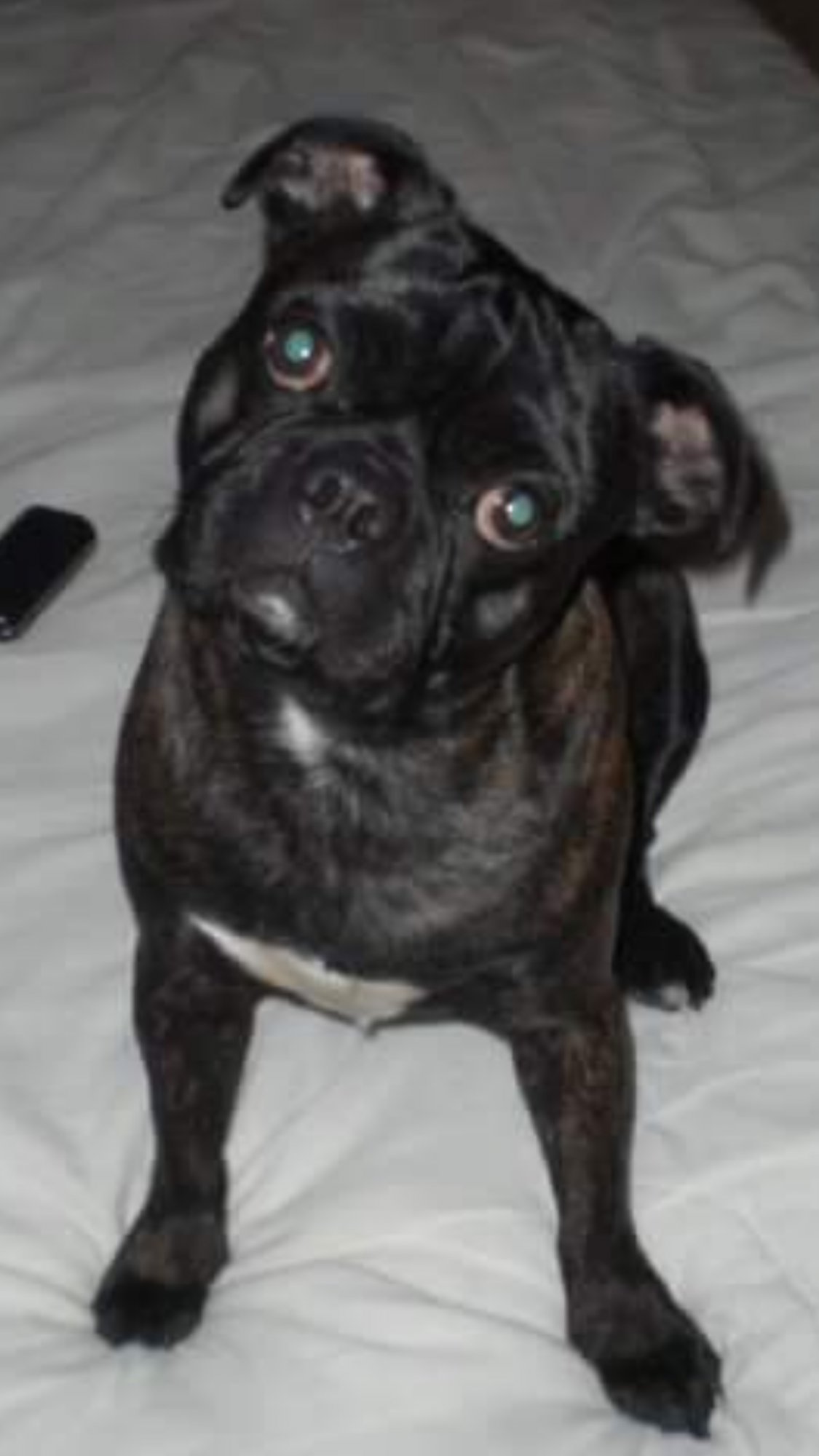 Bruiser is a nine-year-old Boston Terrier mix who was having some discomfort in his hind end. His owners took him to see his family vet. A rectal exam revealed a firm mass just below the anus, hidden under the skin. Surgery was recommended to remove and biopsy the mass.
Bruiser is a nine-year-old Boston Terrier mix who was having some discomfort in his hind end. His owners took him to see his family vet. A rectal exam revealed a firm mass just below the anus, hidden under the skin. Surgery was recommended to remove and biopsy the mass.
This surgery can be a bit tricky. The mass needs to be removed entirely, within healthy tissue to “get it all” or have clean margins. Yet we can’t be overly aggressive! We need to preserve the anus and more importantly, the muscles around it, which are responsible for continence.
Surgery at Brodheadsville Veterinary Clinic went very well. Bruiser had to wear a plastic cone around his head for three weeks. He went home with pain medications and antibiotics. The mass was sent out for biopsy.
The biopsy came back a week later…benign! It was a perianal gland adenoma, a common tumor in this area.
Bruiser is lucky his owners decided to remove the mass while it was fairly small. Removing a larger mass would be much more invasive. Early detection and a good decision from Bruiser’s owners made the surgery and recovery much smoother for Bruiser!
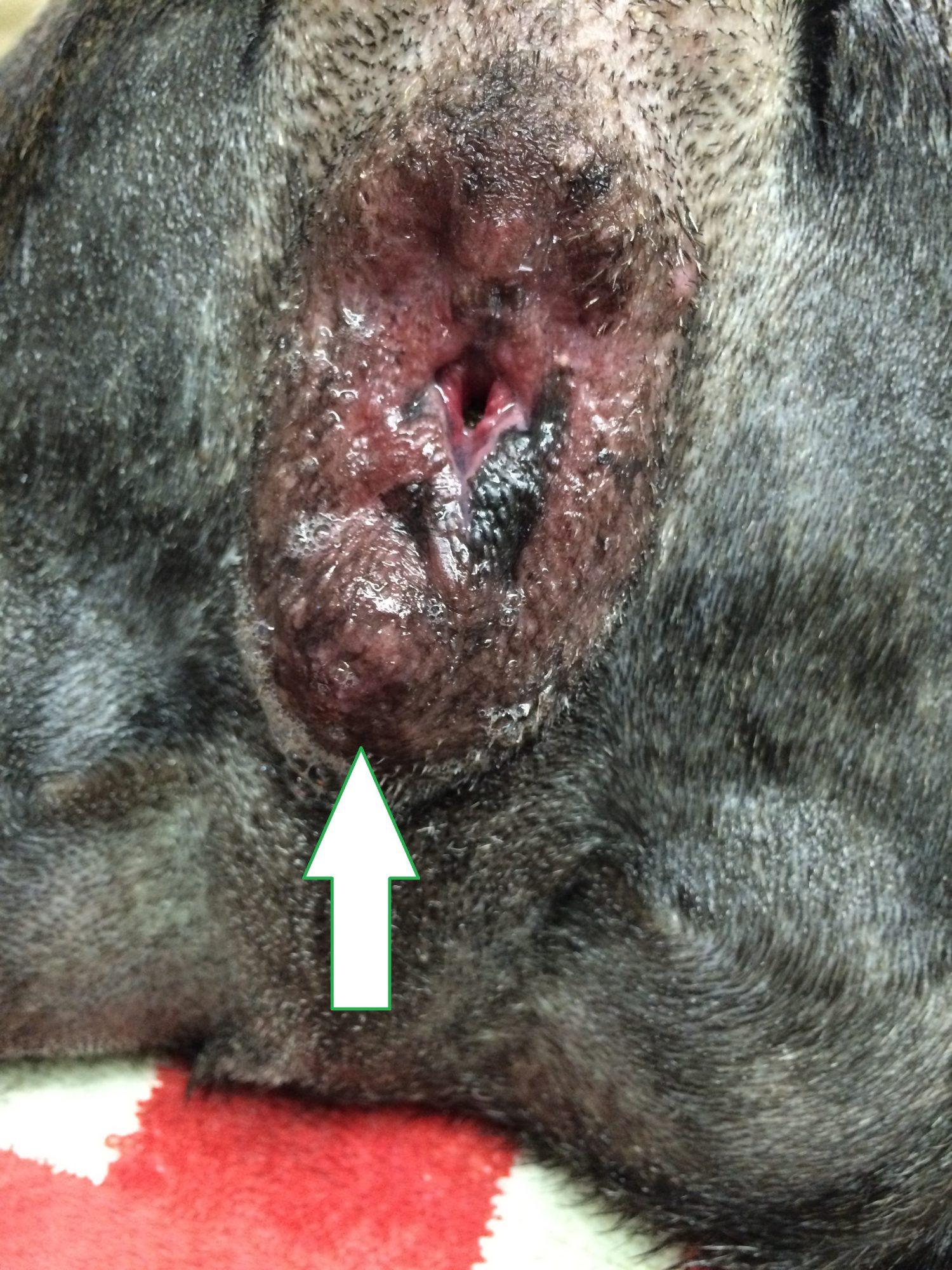
The arrow is pointing to a benign mass.

Dr. Phil Zeltzman is a traveling veterinary surgeon in Pennsylvania & New Jersey. An award-winning author, he loves to share his adventures in practice along with information about vet medicine and surgery that can really help your pets. Dr. Zeltzman specializes in orthopedic, neurologic, cancer, and soft tissue surgeries for dogs, cats, and small exotics. By working with local family vets, he offers the best surgical care, safest anesthesia, and utmost pain management to all his patients. Sign up to get an email when he updates his blog, and follow him on Facebook, too!
Never neglect a pet’s open wound
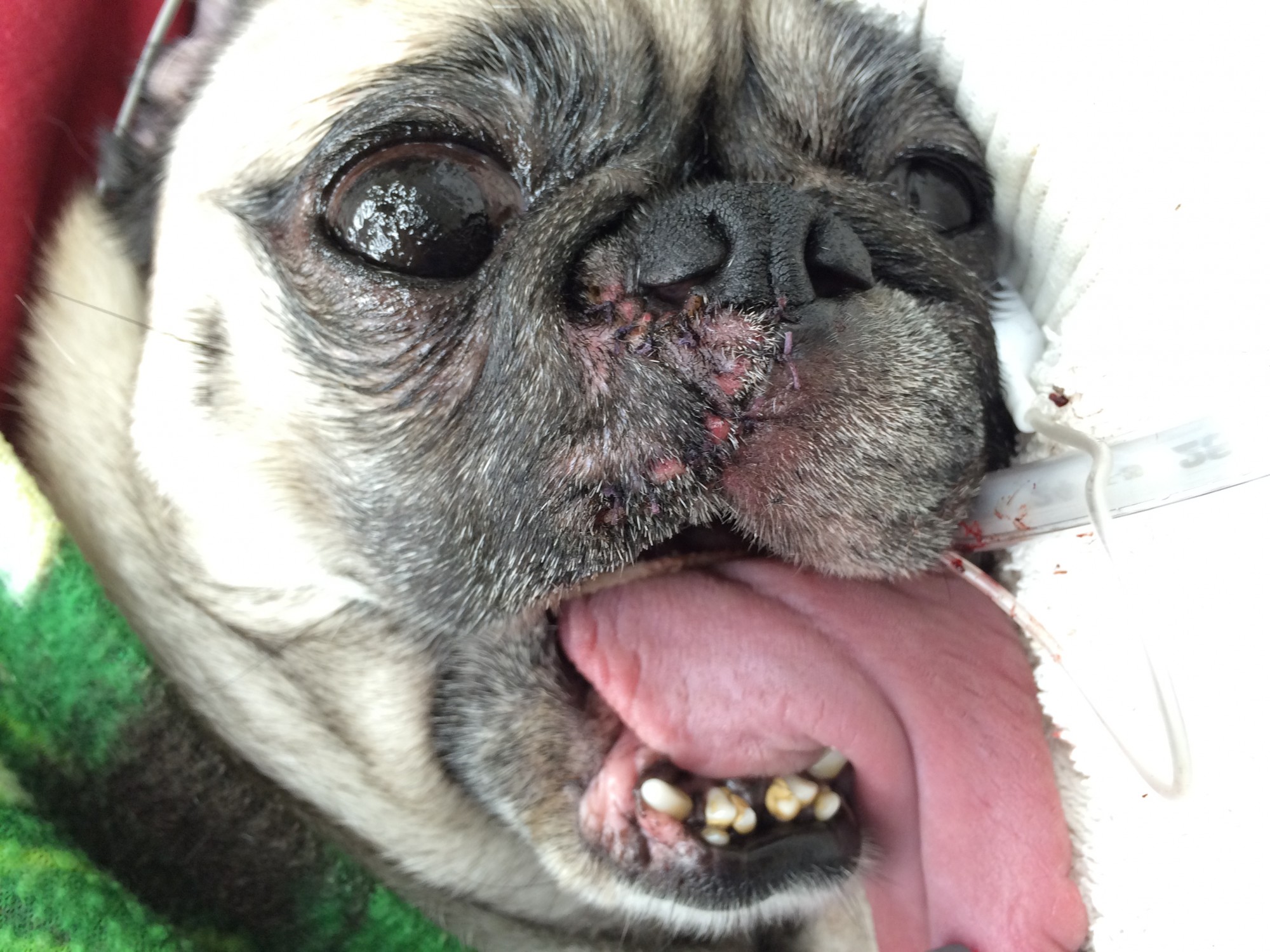
Quinton after surgery.
Quinton is an 8 year old Pug, who had a small open wound that would not heal despite antibiotics.
Quinton’s vet, instead of ignoring the wound, decided to test it. Under the microscope, the cells looked like Quinton could have a mast cell tumor! Mast cells are normal white blood cells that can occasionally cause a tumor. In fact, it’s one of the most common skin tumors. However, they typically appear as a lump or bump, not as an open wound.
I performed surgery at Barton Heights Veterinary Hospital and removed a very large portion of his right upper lip and small section of the left upper lip.
It is very important to remove enough tissue around a tumor in the hopes of getting it all.
The lab confirmed a mast cell tumor. There are 3 grades describing severity of the tumors: 1 is good, 3 is bad. Quinton had a grade 2 mast cell tumor, which we fortunately removed entirely.
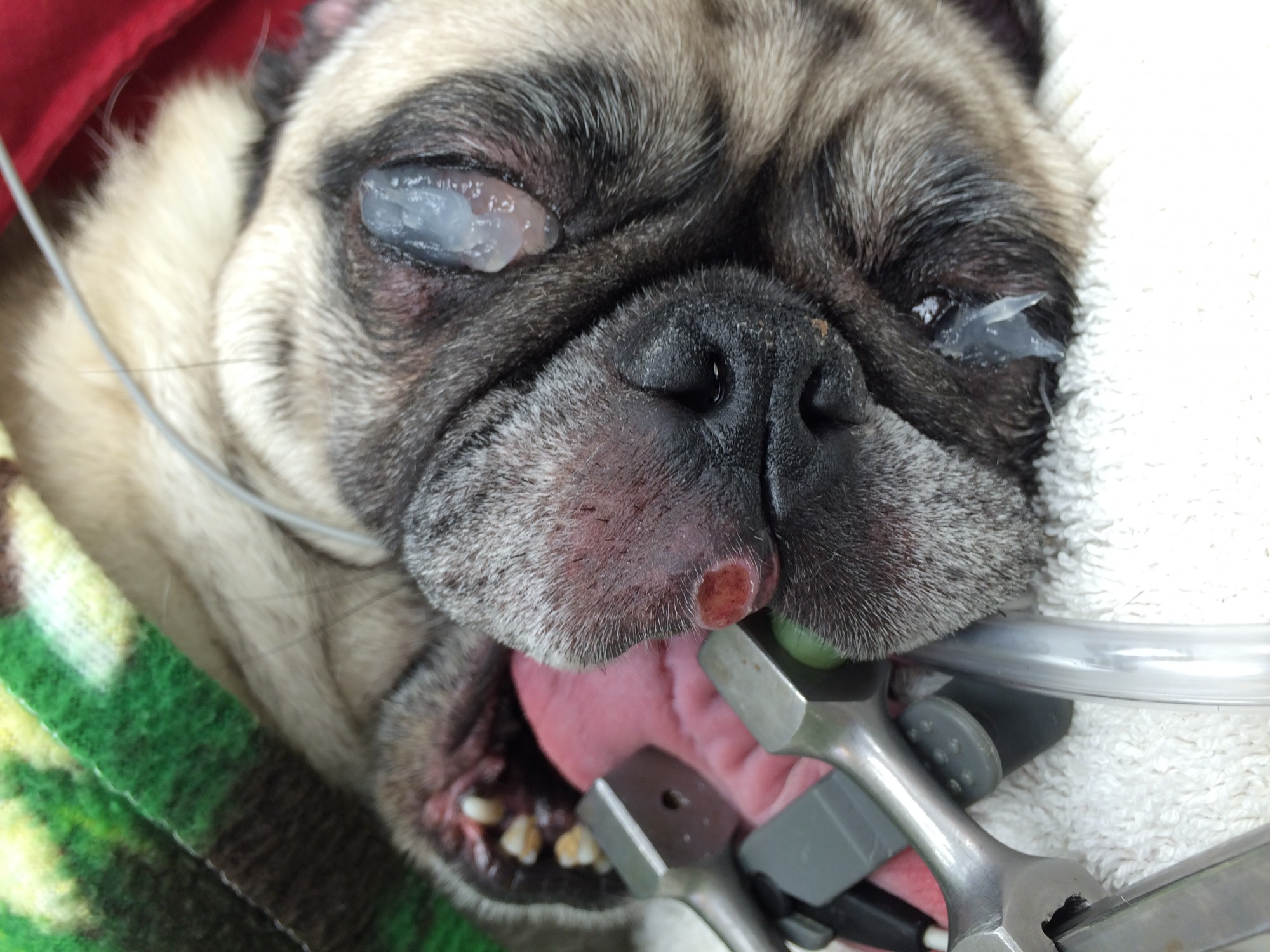
You can see the wound on Quinton’s lip.
Never neglect open wounds! You never know what they can be hiding.

Dr. Phil Zeltzman is a traveling veterinary surgeon in Pennsylvania & New Jersey. An award-winning author, he loves to share his adventures in practice along with information about vet medicine and surgery that can really help your pets. Dr. Zeltzman specializes in orthopedic, neurologic, cancer, and soft tissue surgeries for dogs, cats, and small exotics. By working with local family vets, he offers the best surgical care, safest anesthesia, and utmost pain management to all his patients. Sign up to get an email when he updates his blog, and follow him on Facebook, too!

